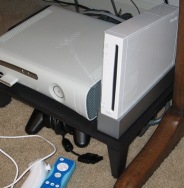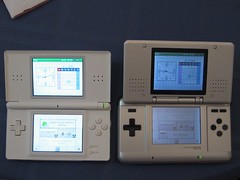 Forgive me, I can’t resist a bad pun. Translation: Week in Review.
Forgive me, I can’t resist a bad pun. Translation: Week in Review.
A little over a week ago I stood in line very early on a cold rainy morning outside Circuit City, and managed to buy one of the thirteen Nintendo Wiis they got in stock that day. Now that I’ve had some serious playtime, here’s my impressions:
Put simply, I love this system. The novel motion sensitive controller works just as advertised – playing tennis feels like tennis, bowling like bowling, etc. Being able to point at the screen to select options makes it much easier to enter text and set options than on previous generations of controllers. The game it comes with, Wii Sports, is an excellent introduction to the Wii. It’s a package of five games: Bowling, Tennis, Boxing, Baseball, and Golf. I haven’t managed to figure out the right timing to hit the baseball reliably, but the other four all work just as advertised. Most game types even let you pass one or two controllers around among players, instead of having to buy more. Boxing is by far the most physically intensive of the five, and can be quite a workout depending on how much you allow yourself to get into it. The Wii controller can be used with multiple intensities – a flick of the wrist, for example, will return a serve just as well as a full arm swing. It’s up to you how you want to play.
The interface of the Wii’s main menu is extremely well laid out. Finding options and starting programs is easy – there are freely downloadable ‘channels’ that let you browse the world’s weather or new by rotating a globe, and another that provides a basic version of the Opera web browser. The console also comes with the ‘Mii Channel’, which is where you design your cartoony avatar. This avatar then shows up in a number of games, primarily as your player in Wii Sports.
Games from previous generations of video game systems are also available to purchase and download (NES, SNES, N64, Sega Genesis, and Turbografix 16 games are all represented). I take a bit of an issue with Nintendo’s pricing on these games – A Super Nintendo game costs $8, and an N64 title is a whopping $10. I won’t buy very many games at these prices. But if they were cut in half, I could convince myself to make the smaller purchase more repeatedly. Logical? Maybe not, but that’s how I feel. As it is, I broke down and bought the original Sonic the Hedgehog. Even after all these years, I still feel surreal playing a Sega game on a Nintendo system. My 10 year old self would never have predicted this day.
Here’s a couple blurbs on the other games I’ve tried:
Rayman: Raving Rabbids
This collection of minigames is the best thing on the Wii so far. There’s something like 75 games available, usually lasting a minute or two to play. Each uses the controller in a novel way – a whack-a-mole style game, swinging a cow over your head before throwing it, and keeping rhythm using the controller like drumsticks are three that come to mind immediately. The single player game is relatively short-lived, but has a very entertaining bizarre sense of humor, and is necessary to unlock the games for multiplayer use anyway. And multiplayer games is where Rayman really shines. Anybody can pick up the controller and play almost instantly. The games are short enough to get everyone in a large group involved, yet still long enough to have some substance.
WarioWare: Smooth Moves
Another collection of minigames, but this time I wasn’t quite so impressed. WarioWare comes up with some more novel ways to use the controller (like holding it to your nose and manipulating an elephant’s trunk), but never really reaches the full potential that Rayman did. Each Wario game can be as short as less than one second, and usually only requires one quick movement of the controller. This makes some of the games frustratingly rely on what feels like blind luck to complete them successfully. It’s fun in the short term, but I managed to complete the single player mode in less than two hours of play over a weekend. Again, like Rayman there’s some extension of the game’s life in multiplayer modes, and WarioWare is definitely worth playing. But something didn’t click for me, and I’m glad I only rented it.
In the end, the success of minigame compilations like WarioWare and Rayman are also the Wii’s biggest weakness. Game developers are still figuring out how to work motion sensing elements into longer, story driven games. With the exception of Zelda (which I have not yet played), none of the attempts so far have been reviewed very well. But the innovation is there, and that’s the key factor. The potential is here, now games just have to follow through. Given time, I have faith that will happen.
The highest praise I have for the Wii is that it has me excited about finding a chance to play the newest version of Madden. Players hike and throw the football with semi-realistic motions, which has me intrigued. And I can’t remember the last time I looked forward to a sports game. I think the last one I bought was for the Playstation 1. Nintendo’s plan to reach out to new groups of gamers just might work.
P.S. If anyone has a chance, give the Huntsville Circuit City some business. The manager on duty brought us a big bag of Sausage McMuffins while waiting outside in the rain at 7AM, just because she thought we looked hungry.






